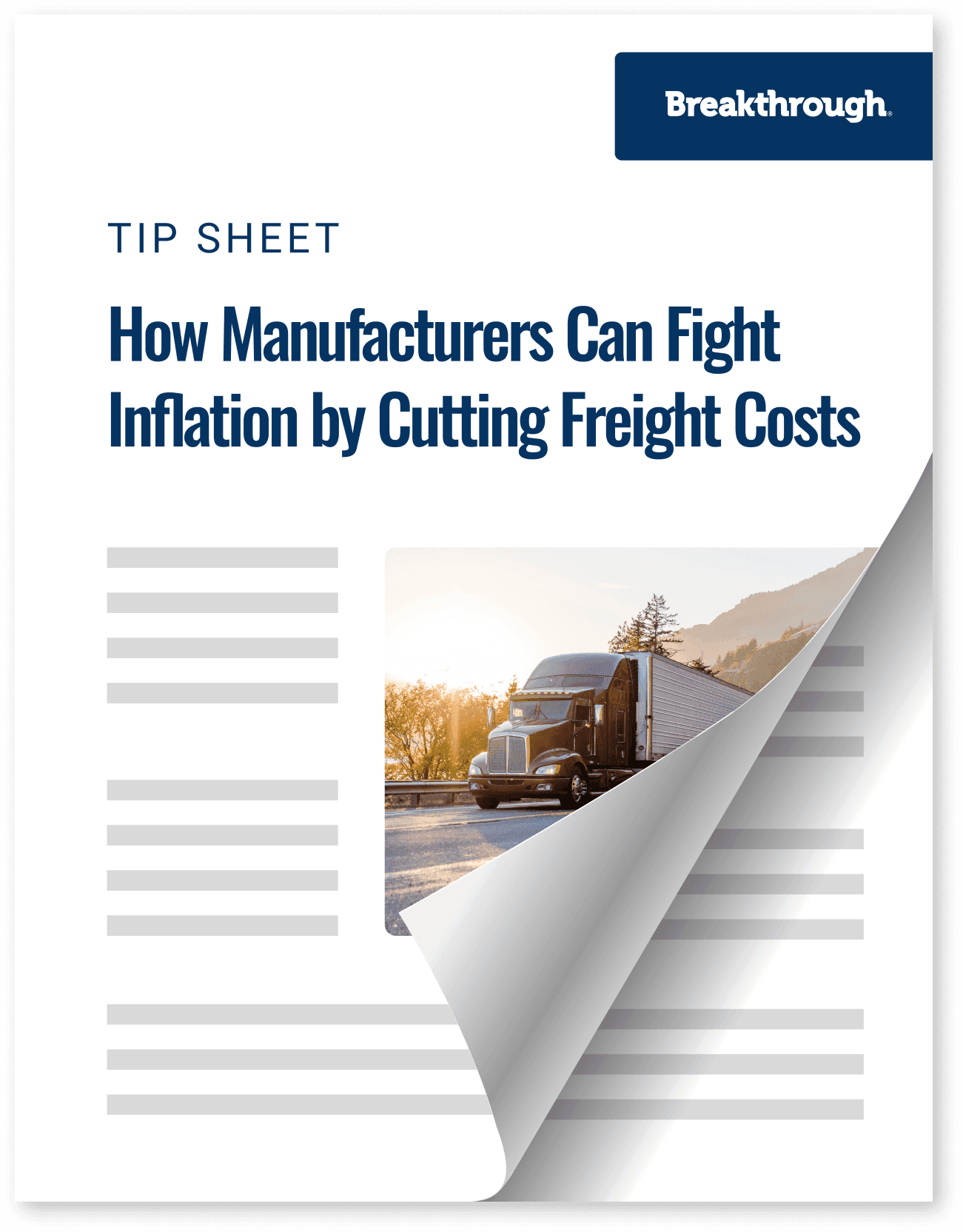Come i produttori possono combattere l'inflazione riducendo i costi di trasporto

Tendenza
Messaggi principali
Sostenibilità e tecnologia
Informazioni sul credito d'imposta per la produzione di carburante pulito 45Z
4 min di lettura
ottobre 3, 2025
Eventi di mercato
Perché i prezzi del diesel sono stabili quando il greggio è in calo?
5 min di lettura
ottobre 2, 2025
Eventi di mercato
Prepararsi alle nuove leggi californiane sulla divulgazione del clima
5 min di lettura
settembre 30, 2025
6 min di lettura
gennaio 18, 2019

Condividi:
Indice
Sfoglia l'indice per passare direttamente alla parte che stai cercando
Da quando siamo nati nel 2004, Breakthrough è stato il pioniere nell'aiutare i caricatori a gestire accuratamente la loro spesa energetica per il trasporto. Ciò che è iniziato nella gestione del carburante per il trasporto su strada in Nord America si è ora espanso a una serie di paesaggi di trasporto, poiché i caricatori riconoscono il valore della gestione del carburante tra le varie modalità di trasporto.Con nuove normative che entreranno in vigore nel 2020, uno dei contesti più critici in cui gestire il carburante è diventato il settore marittimo. Ciò che distingue questo settore sono i fondamentali cambiamenti che sta attraversando, con nuove regole ambientali e ruoli dei vettori, tutti motivati da un elemento critico: il carburante.
Questi cambiamenti hanno messo a nudo le distorsioni nelle pratiche esistenti dei caricatori di carburante marittimo, evidenziando una storia coerente di incoerenza nelle loro pratiche BAF. Per ottenere una vera visibilità e un vero controllo sulla spesa per il carburante marino, i caricatori devono innanzitutto considerare come le seguenti distorsioni possano avere un impatto sulla loro strategia di navigazione oceanica
Le nuove normative dell'Organizzazione Marittima Internazionale (IMO) sullo zolfo hanno innescato un cambiamento fondamentale sia nel prezzo che nella domanda di carburanti marittimi. La maggiore domanda di gasolio a bassissimo tenore di zolfo (ULSD) ha già innescato la volatilità dei prezzi, in quanto il processo di produzione fatica a tenere il passo con la crescente pressione della domanda. Inoltre, i nuovi carburanti marini a basso contenuto di zolfo vengono prodotti nella stessa frazione di distillazione del diesel convenzionale per autocarri, con un conseguente impatto competitivo sulla dinamica dei prezzi anche per le spedizioni OTR.Che si tratti di regolamenti ambientali dell'IMO o di politiche economiche internazionali come le tariffe, questi cambiamenti normativi e i potenziali impatti sui prezzi suscitano risposte drasticamente diverse da parte dei vettori marittimi, compresi i supplementi per il bunkeraggio di emergenza o un movimento strategico verso nuovi tipi di carburante bunker. Senza una visione chiara del BAF, le variazioni di prezzo motivate da questi sviluppi vengono oscurate.
Oltre alle normative, i programmi BAF spesso non spiegano come la geografia e il consumo di carburante sulle rotte commerciali possano influire sui costi. Questo non è meglio esemplificato di come, per le stesse rotte commerciali e gli stessi livelli di servizio, i prezzi BAF possano essere drasticamente diversi, sia che si tratti di un programma basato sul caricatore o sul vettore.com/blog/continuing-response-to-imo-2020-new-carrier-baf-formulas/">Non ci sono due vettori che fissano i prezzi allo stesso modo, e senza un chiaro meccanismo di condivisione di questi calcoli di prezzo, i caricatori spesso rimangono in possesso di una comprensione irregolare del motivo per cui i prezzi BAF sono diversi per i vari vettori.
Una delle sfide principali dei programmi BAF diventa quindi quella di stabilire una base da cui partire per sostenere i miglioramenti tecnologici sulle navi, assicurando che si adattino agli standard del settore. Con i nuovi cambiamenti normativi, molti vettori hanno adottato approcci diversi per affrontarli, impiegando di tutto, dai carburanti alternativi alla tecnologia scrubber a circuito chiuso.Tuttavia, i caricatori spesso non hanno la possibilità di capire come e in che misura questi miglioramenti sono stati apportati. Con la visibilità offerta loro da un programma di gestione del carburante, gli spedizionieri possono assumere il controllo di questi miglioramenti tecnologici, sviluppando un "portafoglio" di carburante e comprendendo meglio come i vettori forniscono valore a coloro che in ultima analisi pagano i loro programmi.
Superare queste distorsioni nella vostra strategia marittima è possibile con Breakthrough Marine Fuel Management. Il nostro programma, solido e basato sui dati, è in linea con i principi fondamentali di Breakthrough: trasparenza, eliminazione delle distorsioni ed equità nelle catene di approvvigionamento dei nostri clienti. Ecco come sbloccare questo valore:
Raggiungere la trasparenza
Per comprendere i costi sottostanti associati ai vostri movimenti di trasporto marittimo, Breakthrough lavorerà con la vostra organizzazione per scoprire le realtà dei vostri attuali programmi BAF. Analizziamo i vostri dati per isolare le distorsioni e le inefficienze, formulando le nostre raccomandazioni sulla base delle vostre realtà di rete.
Rimuovere le distorsioni
Una volta ottenuta la visibilità sulle dinamiche dei costi del carburante marino, Breakthrough sviluppa con voi una strategia di rimborso del carburante basata sul consumo, tenendo conto delle necessarie considerazioni geografiche, di carburante e normative. Nel corso di questo processo, gli spedizionieri passano da un programma BAF trimestrale a un programma basato sul mercato che tiene conto di prezzi del carburante accurati e tempestivi.
Stabilisce l'equità
Il programma di gestione del carburante marino risultante può essere utilizzato per sostituire i programmi BAF esistenti con una strategia basata sul mercato che sia equa e accurata sia per voi che per i vostri vettori. Eliminando i premi per il rischio di prezzo ed evitando inutili supplementi di emergenza, si crea un panorama più competitivo per entrambe le parti, consentendo ai vettori di concentrarsi meno sul carburante e più sul servizio che stanno fornendo.
Con drastici cambiamenti normativi all'orizzonte e una serie di strategie diverse che i vettori utilizzeranno per adattarsi ad essi, il carburante rimarrà una parte significativa della spesa marina dei caricatori per il prossimo futuro. Con l'aumento della complessità del panorama marittimo, i caricatori che implementano un programma che consente loro di vedere e valutare chiaramente la spesa per il carburante avranno un vantaggio competitivo sul mercato.Per saperne di più su come la gestione del carburante marino di Breakthrough fornisce un valore senza pari ai caricatori che operano in alto mare, visitate la nostra pagina delle soluzioni.

4 min di lettura
ottobre 3, 2025
Capire il credito d'imposta 45Z, le sue recenti modifiche e il suo impatto su RNG, diesel rinnovabile e biodiesel. Scoprite come influirà sui vostri obiettivi di sostenibilità.
Leggi di più
5 min di lettura
ottobre 2, 2025
L'andamento dei prezzi del gasolio rimane stabile nonostante il calo dei costi del greggio. Scoprite i fattori chiave, dai margini di raffinazione alle basse scorte, che determinano il mercato odierno.
Leggi di più
5 min di lettura
settembre 30, 2025
Scoprite i passaggi chiave per la conformità alla legge californiana sulla divulgazione del clima. Scoprite come prepararvi ai requisiti di rendicontazione delle leggi SB 253 e SB 261.
Leggi di più